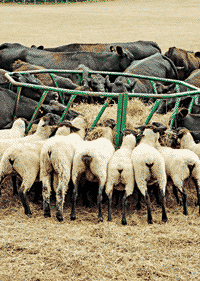Bluetongue-like MCF symptoms confuse farmers

Farmers have spent the past 12 months looking for nasal discharges and runny eyes as classic bluetongue symptoms, but they are also key indicators for malignant catarrhal fever (MCF) and farmers could be unwittingly spreading it.
Housing sheep and cattle together in close proximity is a major risk factor in the spread of MCF but, for a disease that is largely unheard of, farmers should think twice before mixing animals.
With sheep as natural carriers and shedders of MCF, there is a risk of inter-species disease spread. But because cases are rare, the practicalities and economics of shared housing outweigh the risk of MCF, says VLA vet investigation officer Roger Daniel.
“With just 82 cases of MCF reported by the VLA last year compared to 95 in 2007 and 125 in 2006, cases are rare and sporadic. This is a fatal disease affecting all ages of cattle, but these statistics demonstrate cattle are fairly resistant to the disease,” he says.
Juvenile lambs between the ages of two and nine months are thought to be the main factor in the spread of the ovine herpes virus 2 strain of MCF, with all ages of sheep thought to be carriers. And although it is uncertain why certain sheep shed the virus, it is thought transmission to cattle is via aerosols, with mixed housing at winter a prime time for infection.
“MCF is a differential diagnosis for bluetongue and any suspected cases must be seen by a vet because of the similarity of symptoms,” says Mr Daniel. “Following exposure, symptoms normally occur rapidly, with cows exhibiting symptoms such as severe nasal discharge and glazed-over and sometimes runny eyes. Fatal dysentery was also seen in MCF animals last year, which resulted in high mortality,” he says.
